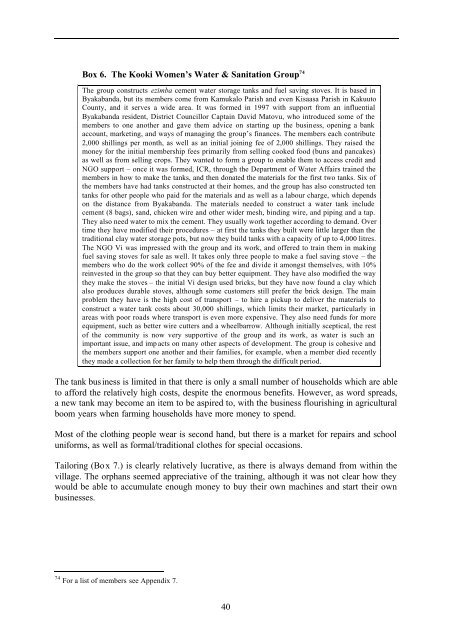Access to Rural Non-Farm Livelihoods - Natural Resources Institute
Access to Rural Non-Farm Livelihoods - Natural Resources Institute
Access to Rural Non-Farm Livelihoods - Natural Resources Institute
You also want an ePaper? Increase the reach of your titles
YUMPU automatically turns print PDFs into web optimized ePapers that Google loves.
Box 6. The Kooki Women’s Water & Sanitation Group 74<br />
The group constructs ezimba cement water s<strong>to</strong>rage tanks and fuel saving s<strong>to</strong>ves. It is based in<br />
Byakabanda, but its members come from Kamukalo Parish and even Kisaasa Parish in Kakuu<strong>to</strong><br />
County, and it serves a wide area. It was formed in 1997 with support from an influential<br />
Byakabanda resident, District Councillor Captain David Ma<strong>to</strong>vu, who introduced some of the<br />
members <strong>to</strong> one another and gave them advice on starting up the business, opening a bank<br />
account, marketing, and ways of managing the group’s finances. The members each contribute<br />
2,000 shillings per month, as well as an initial joining fee of 2,000 shillings. They raised the<br />
money for the initial membership fees primarily from selling cooked food (buns and pancakes)<br />
as well as from selling crops. They wanted <strong>to</strong> form a group <strong>to</strong> enable them <strong>to</strong> access credit and<br />
NGO support – once it was formed, ICR, through the Department of Water Affairs trained the<br />
members in how <strong>to</strong> make the tanks, and then donated the materials for the first two tanks. Six of<br />
the members have had tanks constructed at their homes, and the group has also constructed ten<br />
tanks for other people who paid for the materials and as well as a labour charge, which depends<br />
on the distance from Byakabanda. The materials needed <strong>to</strong> construct a water tank include<br />
cement (8 bags), sand, chicken wire and other wider mesh, binding wire, and piping and a tap.<br />
They also need water <strong>to</strong> mix the cement. They usually work <strong>to</strong>gether according <strong>to</strong> demand. Over<br />
time they have modified their procedures – at first the tanks they built were little larger than the<br />
traditional clay water s<strong>to</strong>rage pots, but now they build tanks with a capacity of up <strong>to</strong> 4,000 litres.<br />
The NGO Vi was impressed with the group and its work, and offered <strong>to</strong> train them in making<br />
fuel saving s<strong>to</strong>ves for sale as well. It takes only three people <strong>to</strong> make a fuel saving s<strong>to</strong>ve – the<br />
members who do the work collect 90% of the fee and divide it amongst themselves, with 10%<br />
reinvested in the group so that they can buy better equipment. They have also modified the way<br />
they make the s<strong>to</strong>ves – the initial Vi design used bricks, but they have now found a clay which<br />
also produces durable s<strong>to</strong>ves, although some cus<strong>to</strong>mers still prefer the brick design. The main<br />
problem they have is the high cost of transport – <strong>to</strong> hire a pickup <strong>to</strong> deliver the materials <strong>to</strong><br />
construct a water tank costs about 30,000 shillings, which limits their market, particularly in<br />
areas with poor roads where transport is even more expensive. They also need funds for more<br />
equipment, such as better wire cutters and a wheelbarrow. Although initially sceptical, the rest<br />
of the community is now very supportive of the group and its work, as water is such an<br />
important issue, and imp acts on many other aspects of development. The group is cohesive and<br />
the members support one another and their families, for example, when a member died recently<br />
they made a collection for her family <strong>to</strong> help them through the difficult period.<br />
The tank business is limited in that there is only a small number of households which are able<br />
<strong>to</strong> afford the relatively high costs, despite the enormous benefits. However, as word spreads,<br />
a new tank may become an item <strong>to</strong> be aspired <strong>to</strong>, with the business flourishing in agricultural<br />
boom years when farming households have more money <strong>to</strong> spend.<br />
Most of the clothing people wear is second hand, but there is a market for repairs and school<br />
uniforms, as well as formal/traditional clothes for special occasions.<br />
Tailoring (Box 7.) is clearly relatively lucrative, as there is always demand from within the<br />
village. The orphans seemed appreciative of the training, although it was not clear how they<br />
would be able <strong>to</strong> accumulate enough money <strong>to</strong> buy their own machines and start their own<br />
businesses.<br />
74 For a list of members see Appendix 7.<br />
40

















